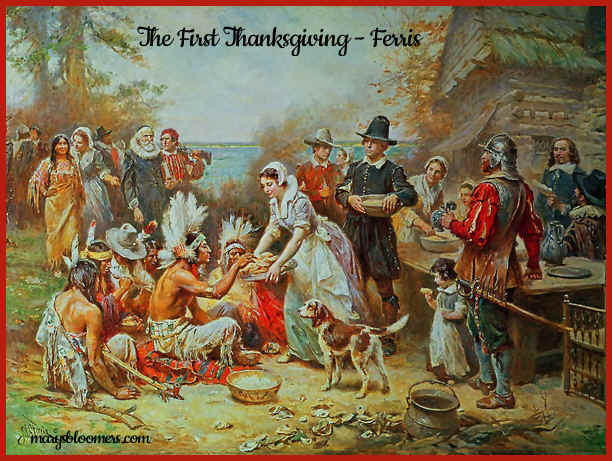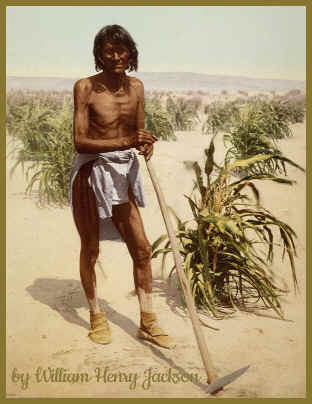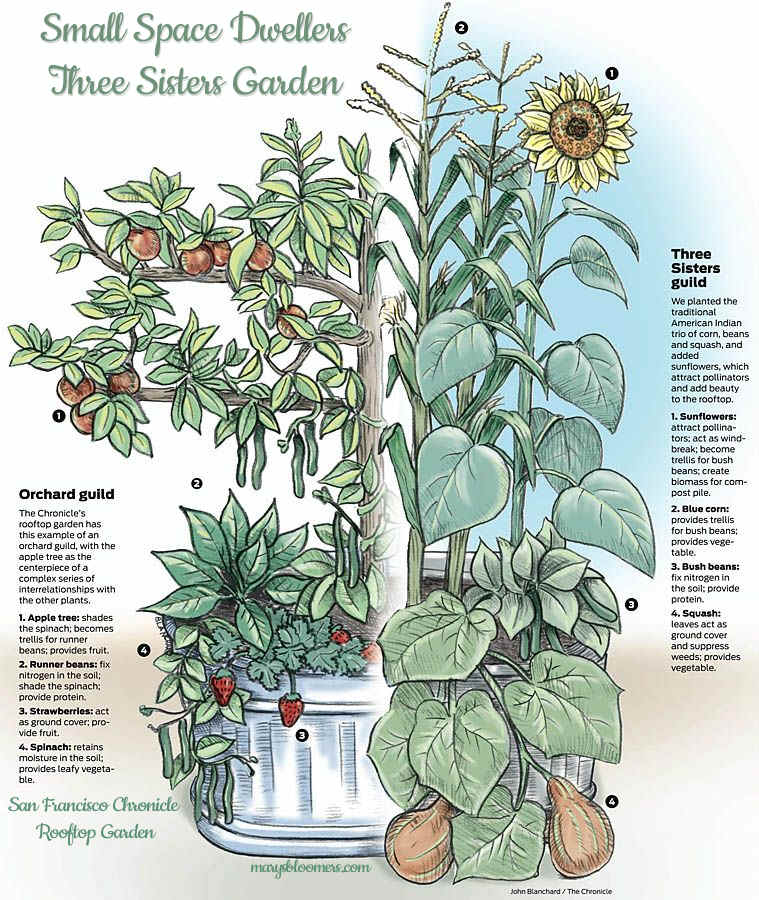We all learned in grade school that it was Squanto, a Wampanoag, who first
taught the Jamestown settlers the art of companion planting and harvesting.
The Pilgrims would have starved to death during the
first winter without that knowledge.
The Wampanoags were known for
their incredible gardening practices and knowledge, and many
neighboring tribes followed the “Three Sisters Garden” design,
along with other methods.
The traditional garden
and the Native diet included corn, beans, squash, and sunflowers. The plants were
fertilized by burying fish in the garden. |

|
The corn and beans are planted in mounds, with squash planted
between the mounds. The beans grow up the cornstalks.The sunflowers are planted along the northern edge of the garden,
so they wouldn't shade the crops, but to attract the
bees and other pollinators into the
garden.
The Native concept of companion planting embraces the belief that
certain plants can benefit others planted close by.
We now have solid evidence that these methods can ward off pests, offer
better soil nutrition, shading, and protection from winds and other
elements. Although the science is still debated, we know that the lessons
in gardening given to the Pilgrims by the Native Americans meant
survival for the settlers of the New World, who had no clue, and
they did it through the teachings of the Three Sisters method of
gardening.
Three Sisters method is an ancient practice, and something to
consider when planning your gardens and preparing for the spring.
The Native American belief in that method harnessed the power of
communal relationships and was helped along by spiritual guidance.
They discovered community gardens long before it became A Thing.
There are several plants with the same attributes that can be grown
with the Three Sisters method.
Here's a chart of some plants and
their favorite garden companions-->
It
seems to me that Native Americans discovered a means for sustainable
agriculture and permaculture, without the present-day frivolous and
haphazard use of chemicals and unnecessary disruption of the earth,
and they followed that practice way before we caught up with the
knowledge and methods.
How
To Design and Grow A Three Sisters Garden
-In late May or early June, hoe
the ground (do not machine-cultivate, plow or rototill) and heap the
earth into piles about a foot high, and about 2 feet across. The centers of your mounds
should be about four feet apart and should have flattened tops.
In the center of each mound,
plant five or six corn kernels in a small circle.
After a week or two, when the corn has grown to be about five
inches, plant seven or eight pole bean seeds in a circle, about six
inches away from the corn kernels.

A week later, at the edge of the
mound about a foot away from the beans, plant seven or eight squash
or pumpkin seeds.
When the plants begin to grow,
you will need to weed out all but a few of the strongest of the
plants from each mound.
As the corn and beans grow, make
sure that the beans are supported by the cornstalks wrapping around
the corn. Use ties if they need help. The squash will crawl out
between the mounds, and vine around the corn and beans.
Native
American Sustainable and Eco-Friendly Gardening Practices
|

|
Many
ancient farming practices
are viewed
as “new” to the modern gardening world,
but they’ve actually been in use for centuries.
These
practices have been
traditionally used by Native Americans to grow large harvests
of food needed for their winter survival, while limiting the
destruction to the earth. The Native American
garden is planted without tilling or plowing.
Native cultures believed that the earth is
sacred, and they resisted cutting too deeply into the earth,
or cultivating it unless it was essential for the success of
the crop.
When clearing land, the hoe and planting
stick were used to loosen roots. These were shaken to loosen
soil, then left in piles to dry for later burning.
Brush and small trees were cut and roots
dug out with planting sticks. Ashes were hoed in, along with
lime and minerals, which made the soil soft and easier to
work. Gardens were allowed to lie fallow for two years
between corn crops. |
Healing Plants
Many indigenous cultures traditionally
use native plants for fuel, construction, tools, fiber, dye, and medicine.
The serviceberry provided edible berries, and also raw
materials for arrows.
The western red cedar tree provided materials for bows, canoes,
lodges, baskets, and containers.
The leaves of mint can be
crushed and placed on the temples to relieve headaches.
The head can be cleared by inhaling the vapor from crushed
eucalyptus leaves.
The majority of herbal medicines are boiled and consumed as a tea.
Terracing
Terracing creates flat planting
beds in hilly terrain. Control of the steep slopes slows runoff,
allowing water to seep into the beds, and it curbs erosion.
Creating terraces in the garden
is beneficial where rain is seasonal, sporadic, and often comes in
heavy downpours. In the southwestern U.S., terracing was key to the
agricultural success of the Anasazi and their descendents, the Hopi,
who still use terraced gardens today.
Irrigation -
Water Wisdom
Thousands of years ago, the
Anasazi people inhabited what is now the Four Corners region of
the U.S., an area known for its low annual rainfall. They
traditionally built catchments, which are dams made of rock that held
onto soil but allowed water to pass through, and reservoirs to
collect the infrequent storm water. The Hopi people of northern
Arizona also use these age-old techniques to irrigate their
gardens in this arid landscape.
No-Till,
No-Dig
No-till farming or
gardening, layer gardening, and lasagna gardening are techniques
that require no turning over of the soil. You simply spread a new
layer of compost on top.
Although tilling chops up weeds
and soil clods, and leaves flat, bare soil that is easily planted, the
practice involves very significant damages to the environment. Mother Nature does not use
a tiller or spade, and she does pretty well without them.
Tilling damages the healthy
soil structure by breaking up soil aggregates, resulting in
powder-like soil particles that are vulnerable to compacting.
That means no water absorption.
It can create a hardpan layer
beneath the tilled area that is impervious to water. That
creates flooding.
It devastates soil life. No-till
methods allows the beneficial organisms, e.g. fungi, bacteria, and
other tiny things - in your soil to thrive undisturbed, making
it a better home for your plants to grow.
Phenology
Phenology is the art of
observing nature for signs in spring that it is safe to plant.
Before planting certain crops, native peoples watched for migrating
birds and animals to return, and for plants and trees to leaf out or
flower. This told them that spring weather was here.
Observing nature is not a
collection of old wives' tales. It is very important during these
days of unpredictable weather and climate change. Average frost
dates are simply averages. Avoid a late spring frost or early
fall frost by paying attention to Mother Nature’s signs.
Depending upon your region, here
are a few examples of phenology:
Plant corn when the oak
leaves are the size of a mouse’s ear.
Plant peas when the forsythia blooms.
Plant cucumbers and squash
when lilac flowers fade.
Seed-Saving
Seed-saving over the centuries
helped gardeners to select and breed the best plants to constantly
improve the crops they were growing. A prime example is maize, which
started out as a wild grain called teosinte, native to Mexico and
Central America. I developed into the corn we grow today.
Long before seed companies
existed, Native peoples have been carefully selecting seeds for
desirable traits, maintaining species purity by planting different
seeds sufficiently far apart from each other to prevent
cross-pollination. Without this effort, corn would be nothing but a
weedy grass.
Crop Rotaton
Crop rotation is another idea
that has been used by indigenous people for thousands of years. It
keeps soil nutrients from being depleted and pests and diseases from
building up, which often happens when one crop is grown in the same
spot year after year.If you grow your tomatoes in the same
garden bed year after year, you will notice an increase in pests and
diseases. Rotate your crops to different beds.
Fertilizing
Farming peoples learned early on
that if you take from nature, you need to give back, so they
routinely returned crop residues to the earth. Where fish were
plentiful, they were buried to rot in the soil. P.S. Today's
woman uses fish emulsion, rather than fish entrails and heads.
Bones and other scraps thrown
into the fire yielded ashes that were scattered in the gardens, and
fields were burned to remove weeds and brush, adding phosphorus and
potash to the soil.
Soil fertility could also be
maintained without adding fertilizer, but by planting beans in the
same hills as other crops, as explained in the Three Sisters garden.
Beans add nitrogen back into the soil, which crops like corn and
squash enjoy immensely.
Micro-climates
Ancient Native Americans didn't
have the word "Micro-climate" in their vocabulary. But
they did know that certain conditions made it possible to start some
plants earlier, and grow them later, during the growing
season.
In areas that received a lot of
sunlight, rocks were traditionally placed around a struggling plant
to absorb daytime heat and radiate it back at night, evening out
temperature swings. Hot stones from a fire pit could be placed
in fields or orchards to protect crops from frost. Most of the
gardening customs of Native American peoples can be considered a
study in Permaculture.
Most microclimates occur
naturally in protected places. Development, chemicals, invasive
plants and tilling, and destroying natural habitats creates the need
for man to re-create a microclimate.
Companion
Plantings That Love Each Other - Three Sisters And A Pot

Orchard and
Three Sisters Potted Rooftop Plantings: Numbers correspond to those in
the above graphic.
There are several combinations of harmonious food plants you can
grow with this method in small spaces
Orchard
1. Apple tree: shades the spinach and becomes a trellis for runner
beans
2. Runner beans shade the spinach
3. Strawberries: act as ground cover
4. Spinach: retains moisture in the soil
Three Sisters
Traditional Native American trio of corn, beans and squash, and added
sunflowers.
1.Sunflowers become a trellis for
bush beans
2. Blue corn: provides trellis for bush beans
3. Bush beans
4. Squash: leaves act as ground cover and suppress weeds
Here is a
wonderful resource for Legends
About Native American Nature Spirits--->
Listing
of vegetable plants and their favorite
...and least favorite companions--->
Recommended
Reading
Article ©2020 Mary Hyland
marysbloomers.com
Sources:
Appropriate Technology Transfer for Rural Areas (ATTRA)
Arizona State University
Native American Gardening - Dover Publications
The Old Farmer's Almanac
American Indian Health and Diet Project
San Francisco Chronicle Rooftop Garden
Detailed
Site Directory-->
Here is a
wonderful resource for Legends
About Native American Nature Spirits--->
Quick Links
|
